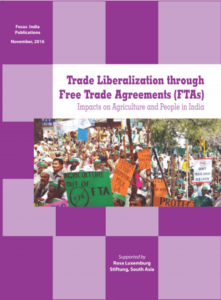
Introduction
Over the past two decades, an increasing number of countries have been following a policy of ever-progressing trade liberalization. India has by no means been an exception to this trend. Despite the tremendous impacts of trade liberalization on Indian agriculture in particular and on people’s livelihoods in general, the consequent Indian governments do not seem to lose their enthusiasm for free trade.
In general, trade liberalization aims at the reduction or complete removal of trade barriers between two countries or amongst a group of countries. This involves the reduction or the removal of both tariff-barriers (such as duties, export subsidies and surcharges) as well as non- tariff-barriers (such as hygiene standards, quotas or licensing rules).
Within the last twenty years there has probably been no other instrument that has influenced and promoted the free trade regime as much as the World Trade Organization (WTO) did. This intergovernmental organization had emerged out of the GATT[1] in 1995 and since then aimed at “ensuring that trade flows as smoothly, predictably and freely as possible.”[2] While the former GATT had only covered trade in goods, with the founding of the WTO, two new treaties, namely GATS (General Agreement on Trade in Services) and TRIPs (Agreement on Trade-Related Aspects of Intellectual Property Rights) were added to the agenda of this new organization. This means that for more than two decades now, trade liberalization does not only cover the trade in goods, but goes much further and also includes the trade in services and investments, as well as other areas such as intellectual property rights, economic or technical cooperation and competition. Under the Agreement on Agriculture (AoA) the free trade regime, moreover, found its way into the agricultural sector, requiring all WTO members to liberalize their agricultural markets and remove all “trade distorting” measures such as subsidies and domestic supports. What is more, is that with WTO a dispute settlement was introduced, which allows the punishment of members that violate trade rules. This mechanism, together with the ongoing removal of trade barriers (especially in the agricultural sector), makes it more and more difficult for governments today to undertake policies that would secure their domestic agricultural and manufacturing sectors. This is especially alarming when it comes to developing countries[3] which highly rely on such policies in order to ensure food security for their population.
In the past, developing countries have consistently pointed out to this fact. They also revealed how the AoA has created a massive dumping mechanism for developed countries’ cheap subsidized agricultural products that have been destroying the livelihoods of small farmers and peasants as they are no longer able to compete with the cheaper goods from developed nations that have been imported into their markets.
Due to such disagreements between developed and developing countries over the agriculture issues, negotiations at the WTO have been stalled for almost a decade since the launch of the Doha Round.4 However, developed nations, with the United States of America (US) and the European Union (EU) leading the way, found new ways to move forward the free trade agenda in the meantime. Today, so-called “Free Trade Agreements” or “FTAs” especially the mega FTAs like Trans-Pacific Partnership (TPP), Trans-Atlantic Trade and Investment Partnership (TTIP) or Regional Comprehensive Economic Partnership (RCEP) are the latest strategy of developed countries to push for access into new markets. As they bring with them unforeseen outcomes for millions of people, many questions can be raised; most of all, in what ways are these trade agreements affecting people in India and other developing countries? Are there new agreements that are being negotiated at the moment? And what are their possible impacts for Indian people in the near future?
This booklet attempts to answer some of these questions in the following four chapters:
Chapter One will provide detailed information on free trade agreements in general and explain how such agreements are different from the WTO.
Chapter Two names some of India’s existing trade agreements and shows some of the negative impacts they already had for people in India.
Chapter Three examines new trade agreements that are currently under negotiation and refers to their projected consequences in different elds, such as agriculture, and access to medicine.
Chapter Four will give a conclusion and some ideas and perspectives on how to (re)act on the new free trade regime.
[1] GATT: The “General Agreement on Tariffs and Trade” (1948 – 1995) was a multilateral agreement regulating international trade. Its purpose was the reduction of tariffs and other trade barriers and the elimination of preferences.
[2] WTO: https://www.wto.org/english/thewto_e/whatis_e/inbrief_e/inbr00_e.htm
[3] Today, developing countries constitute about two thirds of the WTO’s 164 members (WTO: https://www.wto.org/ english/thewto_e/whatis_e/tif_e/utw_chap6_e.pdf



![[IN PHOTOS] In Defense of Human Rights and Dignity Movement (iDEFEND) Mobilization on the fourth State of the Nation Address (SONA) of Ferdinand Marcos, Jr.](https://focusweb.org/wp-content/uploads/2025/07/1-150x150.jpg)

